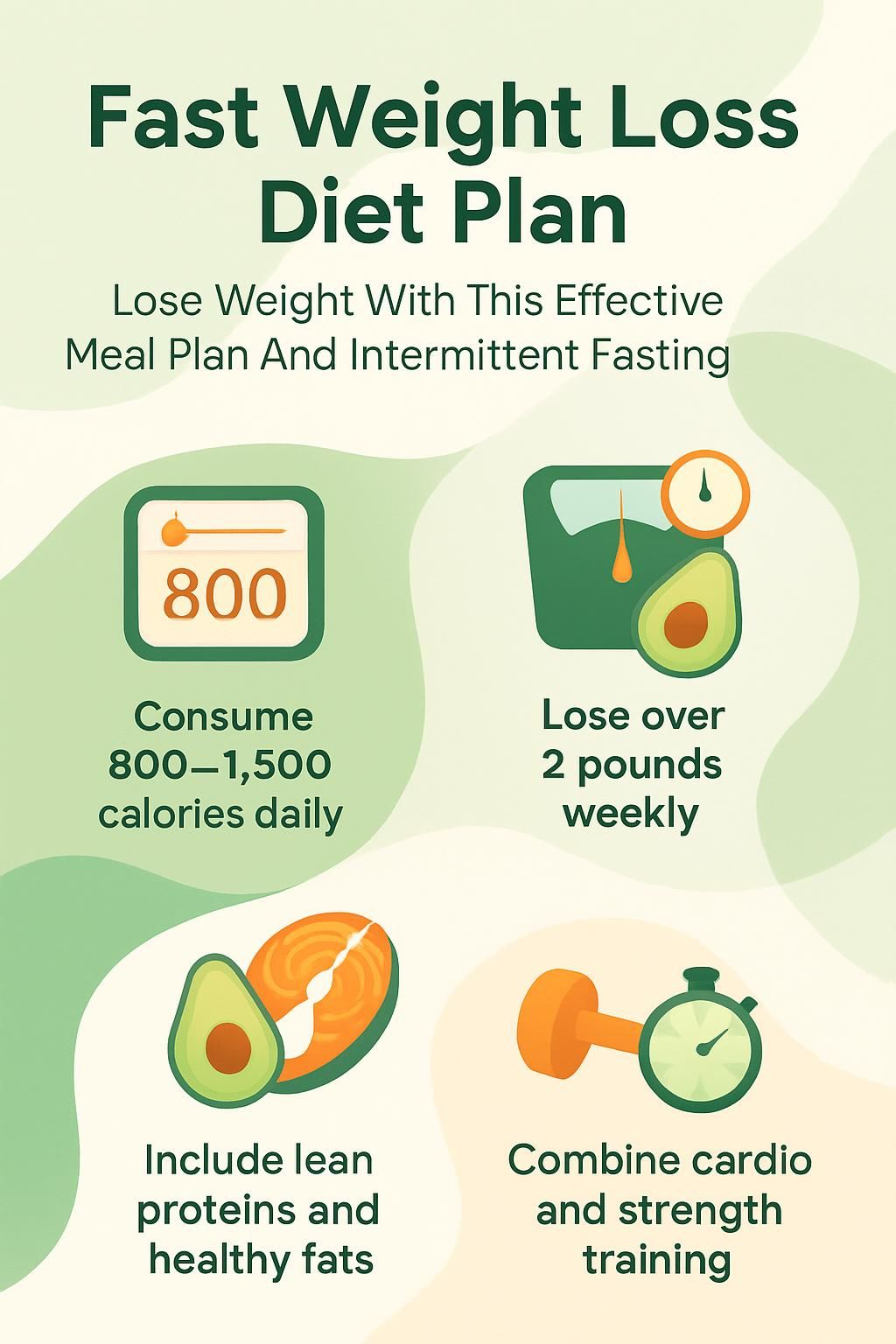Fast Weight Loss Diet Plan: Lose Weight With This Effective Meal Plan And Intermittent Fasting Strategy
Our Nutrition Assistant AI Suite will transform your body. You will lose fat, get toned, and build muscle. Gain confidence and optimal health.
You may work hard to lose weight yet see slow change. A focused weight loss diet plan can speed progress when it pairs a smart meal plan with intermittent fasting. This guide gives you clear steps, safe options, and a sample meal plan you can follow this week.
Inside, you will see how to structure calories, choose high-protein foods, and time your meals for faster results. You will also learn when to get medical help, plus simple ways to keep weight off once you reach your goal.
Key Takeaways
- Fast weight loss plans use low-calorie meal plans, about 800 to 1,500 calories per day, often paired with intermittent fasting, such as time-restricted eating or the 5:2 method.
- Calorie restriction and intermittent fasting together can produce more than two pounds lost per week. Very-low-calorie diets, about 800 calories, may lead to up to five pounds per week with medical supervision (NIH).
- Balanced meals that include lean proteins, healthy fats like olive oil or nuts, whole grains, fruits, and vegetables help prevent nutrient gaps and protect muscle during fast fat loss.
- High-protein diets raise daily calorie burn because digesting protein uses 20 to 30 percent of its energy. Protein also lowers cravings.
- Regular cardio plus strength training speeds fat loss and helps maintain muscle, according to Harvard Health research from 2021.

What Is a Fast Weight Loss Diet Plan and Why Balance Matters?

A fast plan targets quick results while still supporting your health. Balance matters because you want rapid fat loss without fatigue, nutrient gaps, or muscle loss.
What defines a fast weight loss diet plan?
These plans aim for more than two pounds lost per week by creating a larger calorie deficit. Daily calories often range from 800 to 1,500. Some programs include meal replacements to keep portions simple.
Most plans limit added sugars and fried foods, pile on vegetables, and highlight lean protein. Intermittent fasting is common too. Examples include eating all meals within an eight hour window or choosing set fast days each week. Research shows very-low-calorie diets, about 800 calories per day, can produce up to five pounds lost weekly, but they require medical oversight and are not right for everyone.[1]
Personal stories vary. One reader shared, “I cut portions and traded soda for water. I lost ten pounds in three weeks under my doctor’s care.”
“Consistent healthy choices do make a difference,” shares Monica J., who followed both calorie restriction and portion control.
The best approach depends on your health, age, activity level, and guidance from your health care provider.
…
[1]: National Institutes of Health: https://www.nhlbi.nih.gov/health/educational/lose_wt/eat/calories.htm
Why is a balanced approach important for rapid weight loss?
Balance gives your body the nutrients it needs while the scale drops. Cutting healthy fats or complex carbs too much can cause fatigue, slow your metabolism, and make weight regain more likely.
Include lean protein, whole grains, fruits, vegetables, and low-fat dairy. This mix reduces the risk of muscle loss, helps control blood sugar, and supports steady energy. A varied plate also lowers long term risks linked to excess weight, such as type 2 diabetes and heart disease.
In short, a balanced plan helps you lose fat faster while protecting your health, mood, and strength.
Key Elements of an Effective Weight Loss Diet Plan
An effective plan keeps things simple and repeatable. Small daily actions build healthy habits that last.
What is the difference between low-calorie and very low-calorie diets?
Low-calorie diets usually provide 1,200 to 1,500 calories for women and 1,500 to 1,800 for men. They support steady loss with room for variety.
Very-low-calorie diets drop to 800 calories or less. These are short term plans used under medical supervision. They can work fast, yet they also raise the risk of nutrient gaps and issues like gallstones. A health professional should monitor them.
Choosing the right calorie level lowers risk and improves your odds of long term success.
How do healthy fats, proteins, and carbohydrates support weight loss?
Each nutrient plays a role. Healthy fats from nuts, seeds, avocado, and olive oil digest slowly and keep you full. That can curb snacking and help control total calories.
Protein supports muscle and reduces hunger. Your body burns more calories digesting protein than carbs or fat, which helps your metabolism. Good picks include poultry, fish, beans, Greek yogurt, and eggs.
Carbohydrates from whole grains, fruits, and vegetables provide steady energy. Pair complex carbs with protein and fats to stay satisfied and active during the day.
People who combine all three in balanced portions tend to see better results than those following strict fad diets that focus on one nutrient alone.
How can portion control and mindful eating improve results?
Portion control helps you manage calories without counting every bite. Use smaller plates, measure servings, and plate food away from the table to prevent second helpings.
Mindful eating asks you to slow down, taste your food, and stop when you feel satisfied. This reduces emotional eating and late night snacking. Many people notice less stress at meals and better control over cravings with this practice.
Together, these skills build a dependable routine you can keep for life.
Intermittent Fasting Strategies for Weight Loss
Intermittent fasting changes when you eat, not only what you eat. Think of it as a schedule that helps your body tap into stored energy more often.
What is time-restricted eating and how does it aid weight loss?
Time-restricted eating limits meals to a set window each day, such as 10 a.m. to 6 p.m. You then fast the remaining hours. Many people find this easier than tracking every calorie.
This method can reduce total intake and improve insulin sensitivity, which is how your body handles blood sugar. Longer breaks between meals may increase fat burning and lower waist size and blood pressure over time.
How does the 5:2 fasting method work?
The 5:2 plan keeps five normal eating days each week. On two nonconsecutive days, you reduce intake to about 500 to 600 calories per day.
Fasting day meals often include broth based soups, big salads with lean protein, and fibrous vegetables. Research suggests intermittent fasting can support significant weight loss without harming healthy adults.[1] Some studies also show better blood sugar control and stress management.
This method is simple to follow, but it is not safe during pregnancy or for those with certain medical conditions, including kidney disease. Ask your clinician first if you have health concerns.
…
[1] Harvie MN et al., “The effects of intermittent or continuous energy restriction on weight loss and metabolic disease risk markers.” Obes Rev. 2017;18(Suppl 1):8–17.
What is alternate-day fasting and its benefits?
Alternate-day fasting switches between a normal eating day and a low-calorie day of about 500 calories. Many people like the clear on or off rhythm.
Studies report steady weight loss and better metabolic markers with this approach. Fasting days encourage your body to use stored fat for fuel. Over time, this can improve cholesterol and blood sugar, and may lower blood pressure in adults with excess weight.
Some find that weight stays off more easily with this pattern because it teaches portion control and mindful eating on nonfasting days too.
Summary: alternate-day fasting helps you lower weekly calories without constant restriction. The structure makes it practical for many people.
Sample 7-Day Fast Weight Loss Meal Plan
This simple plan offers quick, balanced meals you can mix and match. Use it as a guide, then adjust portions to meet your calorie target.
What are healthy breakfast, lunch, and dinner options for Day 1?
Start with meals that combine protein, fiber, and healthy fats. The goal is steady energy and fewer cravings.
- Greek yogurt with fresh berries and chia seeds for a protein-rich breakfast.
- Grilled chicken over spinach or arugula with olive oil and balsamic vinegar for lunch.
- Baked salmon with steamed broccoli and a half cup of quinoa for dinner.
- Raw nuts, such as almonds or walnuts, as a snack between meals.
- Water or unsweetened herbal tea for hydration instead of sugary drinks.
- A small square of dark chocolate if you want dessert.
- Many readers report these choices keep them full while the scale moves in the first week.
These options reflect a Mediterranean style pattern that supports fat loss without extra sugar.
What meals should I eat on Day 2 for weight loss?
Day 2 builds on the same balance. Keep meals high in protein and fiber, and manage portions.
- Breakfast: Greek yogurt with a handful of nuts and fresh berries.
- Snack: carrot sticks or celery with hummus for healthy fats and fiber.
- Lunch: grilled chicken on leafy greens with tomatoes and an olive oil vinaigrette.
- Snack: an apple or a small banana for natural energy.
- Dinner: baked salmon or tofu with roasted Brussels sprouts and quinoa.
- Evening snack: sliced cucumber and bell peppers, or coleslaw made with cabbage, carrots, and Greek yogurt dressing.
- Drink water throughout the day. Green tea adds helpful antioxidants.
Keeping a regular eating window can make Day 3 feel even easier.
What are meal ideas for Day 3 to lose weight fast?
Day 3 repeats the formula that works. If hunger rises, add extra vegetables first.
- Breakfast: Greek yogurt with berries and a sprinkle of nuts. Add black coffee or unsweetened green tea if desired.
- Lunch: salad with grilled chicken, mixed greens, cherry tomatoes, and olive oil, Mediterranean style.
- Snack: sliced cucumbers or bell peppers with hummus.
- Dinner: baked salmon with steamed broccoli and quinoa for fiber and omega-3s.
- Hydration: aim for at least 64 ounces of water during the day.
- Keep added sugars low and avoid fried foods. Use smaller plates to help portions.
- This pattern keeps calories under control without leaving you worn out for daily tasks.
What meals are recommended for Day 4 in this plan?
Stay consistent, and layer in small tweaks to prevent boredom and keep results coming.
- Breakfast: low-fat Greek yogurt parfait with berries and a small handful of nuts.
- Egg white omelet with spinach and tomatoes, plus half an avocado.
- Lunch: grilled chicken over leafy greens with cucumber, tomatoes, and a tablespoon of olive oil.
- Vegetable soup before the main meal to take the edge off hunger.
- Snack: carrot or bell pepper sticks with hummus.
- Dinner: baked salmon or another fatty fish with roasted Brussels sprouts and steamed quinoa.
- Sweet bite: sliced apple with cinnamon to support stable blood sugar.
- Hydrate with water or unsweetened herbal tea. Skip sugary drinks to avoid weight cycling.
- Practice mindful eating. Slow down and enjoy each bite.
- If you use time-restricted eating, fit meals within an eight hour window during daylight hours.
These steps help you lose weight quickly while protecting energy and mood.
What should I eat on Day 5 to support rapid weight loss?
Day 5 brings variety while keeping your plan simple. Focus on protein and fiber at every meal.
- Breakfast: scrambled eggs with spinach, or Greek yogurt with berries and chia seeds.
- Snack: a small handful of almonds or walnuts for healthy fats.
- Lunch: grilled chicken over mixed greens with tomatoes, cucumbers, and a drizzle of olive oil.
- Snack: carrot sticks or sliced bell peppers.
- Dinner: baked salmon or cod with steamed broccoli and quinoa.
- Drinks: water, herbal tea, or black coffee to avoid extra sugar.
- Use portion control at each meal to keep calories in range.
Pick one meal you love and repeat it this week for an easy win.
What are healthy meal options for Day 6?
Day 6 stays fresh with whole foods and simple prep. Keep it light at night if your activity dips.
- Breakfast: Greek yogurt topped with berries and chopped almonds.
- Lunch: mixed green salad with grilled chicken, cherry tomatoes, cucumber, and one tablespoon of olive oil dressing.
- Dinner: steamed white fish like cod with roasted Brussels sprouts and brown rice.
- Hydration: herbal tea or plain water. Skip sugary drinks.
- Snack: an apple or pear for fiber and volume.
- Portion tip: serve meals on smaller plates to reduce intake naturally.
- Anytime meal: veggie omelet with eggs, spinach, tomatoes, onion, and mushrooms.
- Mindful eating: slow your pace to notice early signs of fullness.
- Snack swap: choose unsalted nuts or seeds instead of packaged snacks.
What meals complete the plan on Day 7?
Finish strong with nutrient dense meals that leave you satisfied, not stuffed.
- Breakfast: Greek yogurt bowl with sliced strawberries, chia seeds, and a sprinkle of oats.
- Lunch: grilled chicken salad with leafy greens, tomatoes, cucumber, and olive oil vinaigrette.
- Snack: sliced carrots with hummus for vitamins and plant protein.
- Dinner: baked salmon with steamed broccoli and brown rice for omega-3s and complex carbs.
- If you use fasting, drink water or unsweetened herbal tea between meals.
- Evening bite: half an apple with one tablespoon of nut butter.
- Adjust portions to match your daily calorie goal. Portion control supports long term maintenance.
Popular Diet Plans to Consider for Weight Loss
Different plans fit different lives. Choose the pattern you can follow most days of the week.
What is a low-carbohydrate diet?
A low-carb diet limits bread, pasta, rice, sugary foods, and many snacks. You focus on protein, nonstarchy vegetables, and healthy fats. Many people see quick early loss as the body uses stored energy.
Some plans, such as the Atkins diet, take a staged approach. If you live with obesity or are considering surgery, your clinician may discuss this pattern as an option.
How does the ketogenic diet promote weight loss?
The ketogenic diet lowers carbs to less than 50 grams per day. This can move your body into ketosis, which means you burn fat for energy instead of carbs.
People often feel less hungry on keto because ketones may affect appetite signals. Studies show greater weight loss in the first six months compared to some low-fat plans. You still need healthy fats, such as olive oil, nuts, and avocados, to stay satisfied.
If you are pregnant or have type 1 diabetes, talk with your doctor before trying keto due to safety concerns with strict carb limits.
What are the benefits of the Mediterranean diet?
The Mediterranean diet centers on fruits, vegetables, whole grains, legumes, nuts, olive oil, and regular seafood. It limits red meat and processed foods.
Research links this pattern with a lower risk of heart disease, improved blood sugar control, and longer life. It supports weight loss because the foods are filling, high in fiber, and rich in healthy fats that help control hunger.
How can a high-protein diet help burn fat?
Protein takes more energy to digest, so your body burns extra calories after protein rich meals. About 20 to 30 percent of protein calories go to digestion and absorption.
High-protein eating also reduces cravings and helps protect muscle while you lose fat. Good sources include chicken breast, fish, eggs, Greek yogurt, beans, and tofu.
What is a plant-based diet and its impact on weight loss?
A plant-based diet focuses on fruits, vegetables, whole grains, legumes, nuts, and seeds while limiting animal products. This pattern is high in fiber, which fills you up on fewer calories.
Studies report greater average weight loss over several months compared to typical Western diets. Many people feel fuller between meals and snack less, which supports steady progress.
How Exercise Can Speed Up Weight Loss
Food sets the stage, and movement helps you keep the show going.
What cardio workouts are best for fat burning?
Running, fast walking, cycling, and swimming burn a lot of calories. High-intensity interval training, called HIIT, mixes short, hard efforts with easy recovery. This approach can reduce body fat in less time.
If you need low impact options, try the elliptical or a rowing machine. Group classes, such as spin or dance cardio, can make workouts more enjoyable and consistent.
How does strength training aid in weight loss?
Strength training builds muscle, and muscle burns more calories than fat, even at rest. A 155 pound person may burn about 112 calories during 30 minutes of weightlifting, according to Harvard Health.
As muscles repair after training, your body uses energy to rebuild them. This supports long term fat loss and helps you look leaner, even before the scale shows big changes.
Pair strength work with cardio during the week for faster, more durable results.
Why is daily movement important for losing weight?
Short bouts of activity add up. Walking after meals, taking the stairs, and standing breaks raise daily calorie burn.
People who reach at least 8,000 steps per day are less likely to gain weight. These habits also prevent plateaus because your total movement stays higher across the week.
Health Benefits of Losing Weight Quickly
Early wins can boost confidence. They can also bring measurable health gains.
How does rapid weight loss improve metabolic health?
Losing 5 to 10 percent of your weight often improves insulin sensitivity. That means your cells use blood sugar better, which lowers fasting glucose and A1C for many people with prediabetes or type 2 diabetes.
Blood pressure and cholesterol levels often improve as well. Liver fat can drop with weight loss, which supports better hormone balance and lower risk for fatty liver disease.
Can losing weight reduce the risk of chronic diseases?
Yes. A 5 to 10 percent loss can lower your risk of type 2 diabetes, heart disease, and high blood pressure. For a 200 pound person, that is 10 to 20 pounds.
Many people also notice better sleep and more energy within weeks. These early changes help you stay motivated to continue the plan.
How does weight loss enhance energy and mood?
Weight loss can steady blood sugar, which reduces energy crashes. With less joint strain, daily movement feels easier, which improves mood.
Regular activity raises endorphins, your brain’s feel good chemicals. That can ease stress and support better sleep patterns.
Risks and Precautions of Rapid Weight Loss
Rapid strategies can be helpful, but they are not right for everyone. Safety comes first.
Who should avoid rapid weight loss diets?
Children, teens, and people who are pregnant or breastfeeding should avoid fast loss plans. Growth and development need steady nutrition.
Those with conditions such as diabetes, heart disease, a history of eating disorders, or a weak immune system need medical guidance before any strict plan. Quick drops in intake can trigger fatigue, dizziness, hair loss, or nutrient gaps.
If you take prescription medication, check with your clinician. Adjusting food timing or calories can affect how some medicines work.
What are the signs of nutritional deficiencies to watch for?
Watch for unusual tiredness, pale skin, frequent headaches, brittle nails, or hair thinning. Mouth ulcers, very dry skin, or muscle cramps can signal vitamin or mineral shortages.
Feeling lightheaded when standing may point to low fluids or electrolytes. If these signs appear, increase nutrient dense foods like leafy greens, beans, yogurt, fish, and lean meats, and speak with a health professional.
When should you consult a healthcare professional?
Seek care right away for severe fatigue, chest pain, fainting, a racing heartbeat, or ongoing nausea. Women with irregular periods, or anyone dealing with constant dehydration or trouble thinking clearly, should talk with a clinician.
If you have diabetes, heart disease, kidney issues, or are pregnant, get medical advice before starting intermittent fasting or any very-low-calorie plan. Professional support keeps you safe while you pursue your goals.
Tips for Maintaining Weight Loss Long-Term
Fast loss feels great, and solid habits help you keep it.
How can I build sustainable, healthy habits?
Start with one or two easy actions, like adding vegetables at lunch or drinking extra water. Habits stick with repetition, so follow the same routines on most days.
Set regular meal times and track food in a simple journal or app. Aim for at least 150 minutes of moderate activity each week. A buddy, coach, or family member can raise your odds of success through accountability and support.
Use reminders on your phone, and reward progress with nonfood treats, such as a movie night or a new book.
What common pitfalls should I avoid during weight maintenance?
Skipping meals often leads to overeating later. Returning to old eating patterns or stopping self monitoring can trigger regain.
Extreme diets are hard to keep and may slow your metabolism. Plan ahead for social events so you have a simple strategy, like eating a protein rich snack before you go.
Do not rely on the scale alone. Track energy, measurements, and how your clothes fit to see real progress.
How do I set realistic goals for long-term success?
Break big goals into smaller steps. A target of one to two pounds per week is realistic for most people and is more likely to last, according to CDC guidance.
Use SMART goals: specific, measurable, attainable, relevant, and time bound. Check in weekly, adjust if needed, and celebrate small wins. Steady progress builds confidence and keeps motivation high.
Conclusion
A fast weight loss diet plan can work well when you pair balanced meals with intermittent fasting and regular exercise. Focus on protein, fiber, and healthy fats, keep portions in check, and use a meal schedule that fits your life.
If you have a medical condition or take prescription drugs, talk with your health care provider before using very-low-calorie methods. With a safe plan, consistent habits, and patience, you can lose weight quickly and protect your health for the long term.
FAQs
1. What is an effective fast weight loss diet plan using intermittent fasting?
An effective fast weight loss diet plan combines a structured meal schedule with periods of eating and fasting. This approach often includes balanced meals rich in lean protein, vegetables, whole grains, and healthy fats during eating windows. Research shows that intermittent fasting can help reduce calorie intake and improve fat burning for many adults (Harvie et al., 2013).
2. How does intermittent fasting support weight loss compared to traditional diets?
Intermittent fasting focuses on when you eat rather than only what you eat. Studies indicate that this strategy may lower insulin levels, boost metabolism, and promote greater fat loss than some continuous calorie restriction plans (Tinsley & La Bounty, 2015). Many people find it easier to follow because it limits the hours available for snacking.
3. Are there risks or side effects linked to rapid weight loss through meal plans and time-restricted eating?
Rapid weight loss can cause fatigue, headaches, or nutrient deficiencies if not managed carefully. Medical experts recommend monitoring your health closely while following any restrictive diet plan (National Institutes of Health). Consulting a healthcare provider before starting helps ensure safety.
4. Can I personalize my meal plan within an intermittent fasting strategy for better results?
Yes; personalizing your meal choices based on age, activity level, medical history, and preferences increases success rates with both fast weight loss diets and time-restricted eating patterns (Varady et al., 2020). For example: When I tried a twelve-hour daily eating window paired with high-fiber foods like lentils and leafy greens at lunch and dinner times last spring semester in college I noticed improved energy levels by week three.
Summary: Fast weight loss plans using intermittent fasting combine scheduled meals with set periods without food intake; evidence supports their effectiveness but careful planning reduces risks; customizing the approach improves adherence as well as outcomes according to credible research findings.
References:
– Harvie MN et al., “The effects of intermittent or continuous energy restriction on weight loss,” Int J Obes (Lond), 2013.
– Tinsley GM & La Bounty PM., “Effects of Intermittent Fasting on Body Composition,” Nutr Rev., 2015.
– National Institutes of Health: Weight Management
– Varady KA et al., “Meal timing strategies for appetite control,” Obesity Reviews, 2020







